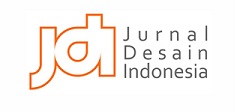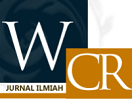KOMUNIKASI FASHION DALAM KEBAYA ENCIM DAN BATIK PERANAKAN TIONGHOA: SOSIALISASI DAN DIFERENSIASI
Abstract
Fashion, clothing and culture are communication and cultural phenomenon, in which fashion communication has both socialization and differentiation function. In the realm of fashion and clothing, the forming of social groups and personal identities are established through continuous communication process. This phenomenon occurred in the development of kebaya encim and Chinese Peranakan batik at Java in the 19th century. Kebaya encim was a type of kebaya worn by Peranakan Chinese women, therefore it had visual characteristics which were eminently influenced by Chinese culture. The Chinese Peranakan women used to wear kebaya as upper clothes, combined with Peranakan Chinese batik cloth as skirt At the beginning, kebaya encim and Peranakan Chinese batik emulated the kebaya and batik characteristics worn by Dutch women in Java. This was due to the desire of Peranakans to acquire equal privilidge with the Dutch in the society.This research aims to define the role of fashion communication in the development of kebaya encim and Peranakan Chinese batik in the 19th century at Java Island. Therefore, this research utilises descriptive qualitative approach. Theories which are used in this research are Barnard's fashion communication theory and Lukman's mimicry and hibridity theory. This research confirms that there is fashion communication process that can be emphasized from socialization and differentiation function with mimicry and hybridity phenomenon in kebaya encim and Peranakan Chinese batik. Socialization can be seen from mimicry of Dutch's kebaya and batik style to obtain social equality. Moreover there is also differentiation function, since the Chinese Peranakans made some special adjustments toward their own kebaya and batik characteristics in order to be more suitable with their culture.
Keywords
Full Text:
PDF (Bahasa Indonesia)References
Barnard, M. (2016). Fashion Sebagai Komunikasi: Cara Mengomunkasikan Identitas Sosial, Seksual, Kelas dan Gender. Yogyakarta: Jalasutra.
Bhabha, H. (2004). Location of Culture. London: Routledge.
Budianto, E.R. (2019). Identitas Elemen Estetik Batik Peranakan Tionghoa 'Oey Soe Tjoen' Generasi Pertama. Tesis Program Magister Institut Teknologi Bandung, Bandung.
Calosa, M. (2014). Teknik Mendesain Kebaya Sendiri. Jakarta: Prima.
Chavalit, K.M, Phromsuthirak, M. (2000). Costumes in ASEAN. Bangkok: ASEAN Committee on Culture and Information of Thailand.
Forshee, J. (2006). Culture and Customs of Indonesia. London: Greenwood Publishing Group.
Gillow, J. (1992). Traditional Indonesian Textilles. London: Thames and Hudson Ltd.
Knapp, R.G. (2012). The Peranakan Chinese Home: Arts and Culture in Daily Life. Singapura: Tuttle Publishing.
Knight-Achjadi, J., Damais, A. (2006). Butterflies and Phoenixes: Chinese Inspirations in Indonesian Textile Arts. Singapura: Marshall Cavendish Editions.
Lee, P. (2014). Sarong Kebaya: Peranakan Fashion in an Interconnected World 1500-1950. Singapura: Asian Civilizations Museum.
Lee, T. (2016). Defining the Aesthetics of the Nyonyas’ Batik Sarongs in the Straits Settlements, Late Nineteenth to Early Twentieth Century. Asian Studies Review, 40(2), 173–191. https://doi.org/10.1080/10357823.2016.1162137.
Lukman, C.C., Piliang, Y.A., Sunarto, P. (2013). Kebaya Encim as the Phenomenon of Mimicry in East Indies Dutch Colonial's Culture. Art and Design Studies, 13, 15-22.
Mahmood, D.S.E. (2012). The Nyonya Kebaya: A Century of Straits Chinese Costume. Singapore: Tuttle Publishing.
Moleong, L.J. (2001). Metodologi Penelitian Kualitatif. Bandung: PT Remaja Rosdakarya.
Neo, C.O.K. (2011). Kebaya Nyonya. Singapura: Forst Printers Pte Ltd.
Roojen, P.V. (2001). Batik Design. Amsterdam: Pepin Press.
Setiawan, F. (2011). 50 Galeri Kebaya Eksotik nan Cantik. Jakarta: Penebar Plus.
Simmel, G. (1997). The Philosophy of Fashion. Chicago: University of Chicago Press.
Sumarsono, H., Ishwara, H., Yahya, L.R.S., dan Moeis, X. (2018). Batik Pesisir Pusaka Indonesia: Koleksi Hartono Sumarsono. Jakarta: Lintas Persada Anugerah.
Suryadinata, L. (1984). Dilema Minoritas Tionghoa. Jakarta: PT Grafiti Pers.
Tan, C.B. (1988). Structure and Change: Cultural Identity of the Baba of Melaka, Bijdragen tot de Taal-, Land- en Volkenkunde (Journal of the Humanitites and Social Sciences of Southeast Asia), 144(2),297-314. https://doi.org/10.1163/22134379-90003298.
Veldhuisen, H.C. (2007). Batik Belanda 1840-1940: Pengaruh Belanda pada Batik dari Jawa, Sejarah dan Kisah-kisah di Sekitarnya. Jakarta: PT Gaya Favorit Press.
Wang, Y. (2023). Fashion: An essential factor influencing the development of 19th to 20th centuries Peranakan decorative motifs, Cogent Arts & Humanities, 10(1), 2198321. 10.1080/23311983.2023.2198321.
Yarwood, D. (1978). Illustrated Encyclopedia of World Costume. New York: Dover Publications Inc.
Zwain, A., Bahauddin, A. (2021). Malacca’s “Straits Chinese traditional courtyard eclectic style shophouses”: facades’architectural design elements through place identity. Journal of Cultural Heritage Management and Sustainable Development, ISSN 2044-1266,https://doi.org/10.1108/JCHMSD-02-2021-0014
DOI: http://dx.doi.org/10.22441/narada.2023/v10.i3.002
Refbacks
- There are currently no refbacks.
Fakultas Desain dan Seni Kreatif
Universitas Mercu Buana
Gedung E Lantai 4
Jl. Raya Meruya Selatan no.1, Kembangan, Jakarta 11650
Tlp./Fax: +62215871335
Journal International Standard Serial Number (ISSN) Registration:
The Journal is indexed by:
Tools for Citations & Plagiarism Detection:

Ciptaan disebarluaskan di bawah Lisensi Creative Commons Atribusi-NonKomersial 4.0 Internasional
 NARADA: Jurnal Desain dan Seni
NARADA: Jurnal Desain dan Seni

























